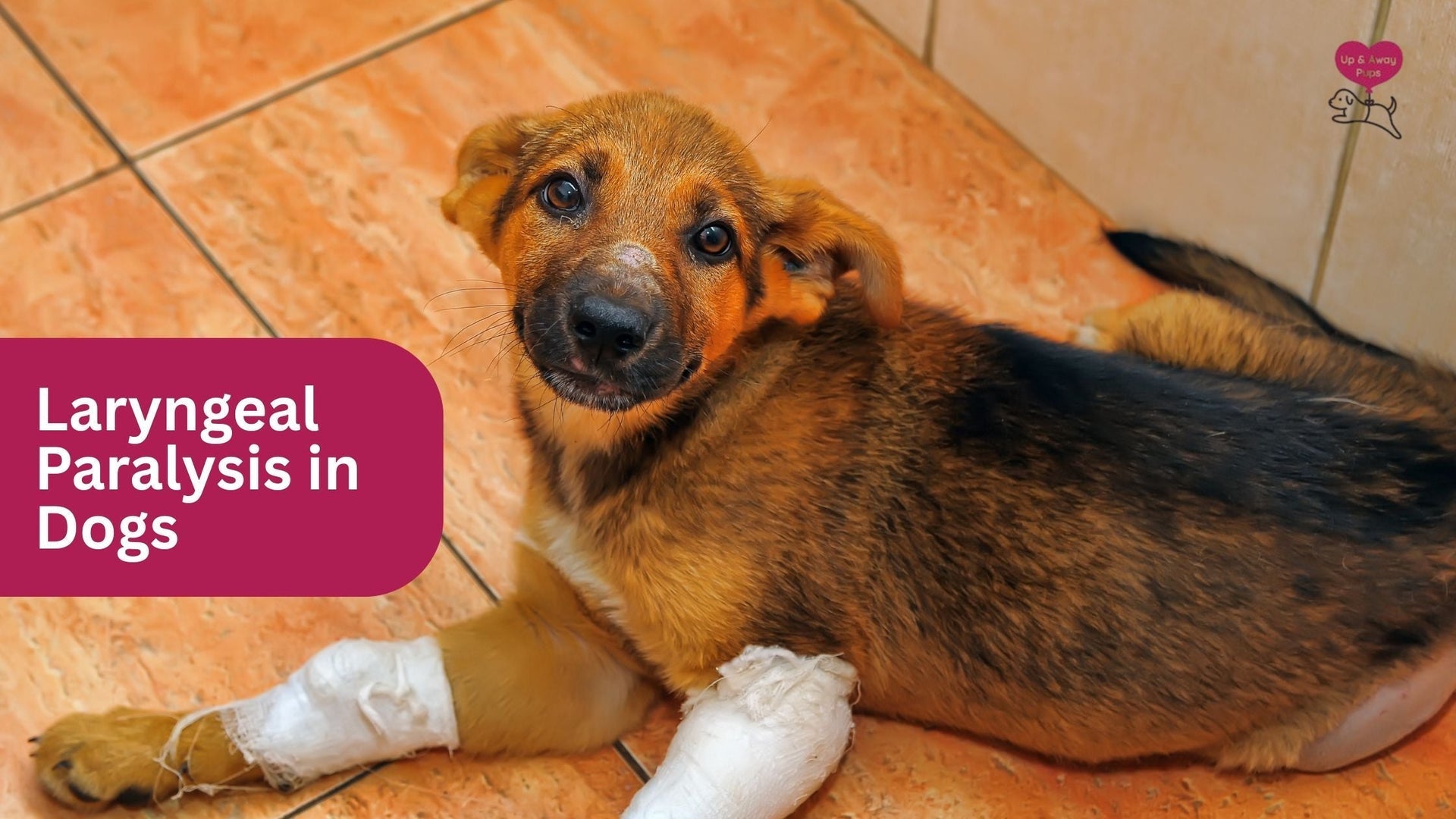Laryngeal Paralysis in Dogs: Causes, Symptoms, and Treatment Options
Laryngeal paralysis is a serious condition that affects a dog’s ability to breathe due to weakened or paralyzed muscles in the larynx. It’s most common in large, older dogs like Labradors and Golden Retrievers. Early signs include noisy breathing, a weak bark, and exercise intolerance. Though it’s not curable, the condition is manageable through lifestyle changes, medication, or surgery. Timely diagnosis and proper care can help affected dogs live comfortably and safely.
Dogs, despite our never-ending prayers for their health and well-being, unfortunately, do get afflicted by diseases and conditions, just like every other life form on this planet. One of these conditions, which many pet owners are unaware of, is laryngeal paralysis. This condition causes difficulty breathing for our furry friends. In this blog post, we’ll learn about this condition as well as what measures we can take to prevent, control, and fix it.
Some Words You Should Know
Before we begin, let’s break down some of the medical terms we’ll use in this article so it's easier to follow along and truly grasp everything.
- Laryngeal paralysis is the condition we’ll be focusing on. It is the loss of function in the muscles that open the larynx, which makes it difficult for a dog to breathe properly.
- The larynx refers to the voice box. It’s a structure located at the top of the trachea that controls airflow and prevents food from entering the lungs.
- The trachea, also called the windpipe, is the tube that carries air from the voice box (larynx) to the lungs.
- Laryngoscopy is the procedure where a vet looks inside the throat with a scope to diagnose the condition.
All About Laryngeal Paralysis in Dogs
Laryngeal paralysis is a condition that affects a dog's ability to breathe properly. Whilst technically any animal with a larynx and trachea can develop this condition, dogs and horses are usually the most common victims because of how their bodies are built and how much they rely on heavy breathing during activity. It is a serious health condition that significantly impacts a dog's ability to lead a quality life.
What happens is the muscles that control the movement of the larynx become weak or paralyzed. This results in the airway being partially, or in the worst-case scenario, fully blocked, rendering a pup unable to perform basic functions like breathing, swallowing, and vocalization. The inability to breathe and eat properly can unfortunately lead to the dog passing away if left untreated.
Are All Dogs Prone To It?
Whilst technically all dogs have a larynx and a trachea and can develop the condition, not all dogs are prone to laryngeal paralysis.
Large and giant breeds such as Labradors, Saint Bernards, Golden Retrievers, and Irish Setters are the most commonly affected, with most cases found in dogs over 8-10 years of age. Some breeds, like Bouviers des Flandres, Dalmatians, and Siberian Huskies, can have it from birth, though it's much rarer.
Also, small dog breeds like Shih Tzus and Cocker Spaniels can develop it, but it is very rare. The same goes for young and healthy dogs—unless they have a genetic condition or sustain an injury, they’re unlikely to be affected.
Clinical Signs of Laryngeal Paralysis in Dogs
Since laryngeal paralysis in dogs is a condition that tends to be found in older dog. Dogs becomes seniors after 7 years of age. It takes time to develop and is unfortunately often mistaken as a general consequence of aging. However, early detection can save a life.
Early Signs and Mild Symptoms
It starts off with subtle changes in breathing patterns, like an increase in respiratory noise and the creation of a harsh and raspy sound when the dog is excited or engaged in physical activity. The dog’s bark may sound weaker or more hoarse than usual, a condition called dysphonia.
These early signs are often ignored because, while the dogs may struggle, they endure it. However, if you pay close attention, you’ll notice a major decrease in your dog’s stamina. They’ll struggle with mundane activities like running or climbing stairs, as the inability to breathe properly directly results in them tiring out faster. In some cases, mild coughing or gagging, particularly after eating or drinking, may also be observed.
Here is a list of the common signs of Laryngeal Paralysis as provided by Cornell Richard P. Riney Canine Health Center:
- Loud or rough breathing
- Heavy panting
- Persistent coughing
- Choking or retching
- Bringing up food or liquid
- Struggling with heat or physical activity
- Altered bark sound
- Breathing difficulties
- Bluish tint on tongue or gums
- Sudden loss of strength or consciousness
Severe and Life-Threatening Symptoms
If the situation worsens, and in advanced cases, laryngeal paralysis can lead to significant respiratory distress. A critical sign is when a dog reaches the point of oxygen deprivation, a condition called cyanosis, in which the mucous membranes (such as the gums and tongue) develop a bluish tint. This means the dog requires immediate medical attention.
As the obstruction worsens, the dog experiences further difficulty breathing and may panic. Since symptoms tend to worsen over time, early detection is crucial, as the condition becomes life-threatening if left untreated. Veterinary check-ups can help determine the severity of the condition and provide management strategies accordingly.
Diagnosis of Laryngeal Paralysis in Dogs
Diagnosing laryngeal paralysis in dogs involves a combination of physical and medical tests to reach a solid conclusion. While we do not recommend self-diagnosis, if you notice noisy breathing, a weak bark, and fatigue paired with signs of trouble breathing—such as wheezing or struggling to take in air—it's best to visit the vet as soon as possible.
Laryngoscopy – The Main Test
The most reliable way to confirm laryngeal paralysis is through a laryngoscopy. In this procedure, the vet sedates the dog and uses a small camera to examine the larynx. In a healthy dog, the laryngeal cartilage opens when breathing in, but if they remain still or barely move, the diagnosis is confirmed.
Additional Tests
Since laryngeal paralysis can be part of a larger nerve or muscle disorder and may be linked to other health problems, vets often conduct additional tests, such as:
-
Chest X-rays – To check for pneumonia or other lung and heart issues.
-
Bloodwork – To rule out metabolic causes like hypothyroidism, which can contribute to nerve dysfunction. Hypothyroidism occurs when the thyroid gland doesn’t produce enough hormones, leading to a slow metabolism, weight gain, and low energy.
-
Neurological Exam – If symptoms suggest a broader nerve-related condition, further tests may be conducted to assess overall nerve function.
Early diagnosis is crucial, as severe cases can result in the dog being unable to breathe. Once diagnosed, the vet will discuss treatment options based on the severity of the condition to help the dog breathe more easily.
Treatment Options for Laryngeal Paralysis
Unfortunately, laryngeal paralysis cannot be cured or reversed, but it is manageable. The approach, however, depends on the severity of the condition and your dog’s overall health.
Here’s a breakdown of the most common treatment options:
Medical Management
For milder cases wherein dogs aren’t approved for surgery, several recommendations are provided to improve the dog’s quality of life. For example, keeping the dog at a healthy weight, using anti-inflammatory medication to ease airway swelling, as well as administering sedatives to calm anxiety and improve breathing.
A more day-to-day recommendation is avoiding exercising too much (but some exercise is important. it is a myth that dogs don’t need the exercise) making use of a harness instead of a collar, avoiding hot weather, and elevating the food and water bowls for your dog’s comfort.
Surgical Intervention
In cases ranging from moderate to severe, surgery is often recommended as the best option, and the most common procedure is called a tie-back surgery or arytenoid lateralization. Here, one side of the larynx is opened permanently for better airflow, significantly improving the breathing and quality of life for the pup. However, it does pose a risk with an increased chance of aspiration pneumonia and sensitive post-operative care like close monitoring, follow-up visits, changes in diet, and more.
Lifestyle Adjustments
Similar to what was recommended in mild cases, lifestyle changes can help manage symptoms to a great extent. Here are some of the best practices:
-
Hot weather is a no-no
-
Stressful situations are another big no. Create a safe and comfortable space at home.
-
Gentle, low-impact exercise is the best.
-
Actively keep an eye on your dog’s breathing
-
Make sure the food isn’t tough to swallow
-
Make water and food bowls easily accessible
-
Careful playtime, no roughhousing
Conclusion
As challenging as laryngeal paralysis may seem, early diagnosis, appropriate treatment, and a proper plan of action can ensure your dog continues to live a happy life. The key is to recognize the symptoms, keep an eye out for them, and visit a vet immediately if you notice any. That’s the best thing you can do for your beloved old dog.


